NICER / ISS Science Nugget
for Oct 1, 2020
NICER discovers the long-term decay of a millisecond pulsar's orbit
Following a 2020 September 29 report, from the German-Russian Spektr-RG mission's ART-XC survey telescope, of increased
activity in the direction of IGR J17379-3747, NICER executed a target-of-opportunity observation of this known neutron-star
binary, which NICER identified in 2018 as harboring an accreting millisecond pulsar. We quickly were able to detect its coherent
pulsations at the expected 468.05 Hz spin frequency, definitively establishing that IGR J17379-3747 is indeed once again in outburst.
The pulsar and its companion star orbit each other every 2 hours. Precise analysis of pulse arrival times enables us to determine
when the neutron star passes through the ascending node, a fixed point on its orbital trajectory. Together with archival data from
NASA's Rossi X-ray Timing Explorer (RXTE) mission reaching back to 2004, NICER's new observation this week shows (see Figure)
that this passage is occurring, over the span of years, increasingly earlier. The trend demonstrates that the orbital period is
steadily decreasing, which in turn implies that the entire binary system is slowly contracting. The high-precision NICER data is key
to this result, where the new 2020 data point yields, for the first time, a measurement of this contraction rate: the orbital period is
decreasing by 95 microseconds every year. What physical mechanism is driving this steady contraction is the topic of continued
investigation.
This result, led by Dr. Peter Bult (NASA GSFC), is reported in Astronomer's Telegram #14056.

Figure: Changes in the time at which the neutron star in the X-ray binary IGR J17379-3747 crosses the ascending node, relative to a model
that assumes a constant orbital period; if the period were constant, there would be no (or a linear) trend. The high-precision 2018
and 2020 NICER measurements demonstrate that the long-term trend is quadratic, offering a measurement of the rate at which
the orbital period is evolving.
<< Previous
Main Index
Next >>